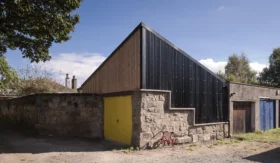
Early Bird Offer! Free tickets to meet independent experts at this summer's Build It Live
Save £24 - Book Now!
Early Bird Offer! Free tickets to meet independent experts at this summer's Build It Live
Save £24 - Book Now!Creating a connection between your home and its surroundings can significantly elevate your overall design and the enjoyment of your space. One of the most effective ways to achieve this is through thoughtful view framing.
From oceans and mountains to modest courtyards and busy streetscapes, the way you highlight these features can enhance your interiors, blur the boundary between inside and out, and make your home feel more spacious and inviting. Here, I’m looking into how to make the most of the unique outlooks your site has to offer, plus some of the main solutions to consider for an effective design.
Curating views isn’t just about aesthetics; it’s a fundamental aspect of your home’s design that influences how your space feels and functions. “At the heart of our approach to every project is the consideration of the available sightlines and vistas,” says Matt Withers, director at Stylus Architects. “These elements are essential for creating a natural flow through the property.” By strategically framing a scene, you can draw focus to specific features, create a seamless connection with the outdoors and even influence the mood and atmosphere within your property.

Designed by Stylus Architects, this home’s garden is beautifully highlighted by contemporary, chunky, black- framed glazed doors
“Beyond simply creating something nice to look at from the inside; it’s about making the landscape a living part of the home,” says Ella Thorns, architect at Studio Bark. “Views bring natural light and a sense of spaciousness, but they also tie the house to its site.” This integration enhances visual appeal and celebrates your surroundings, creating a home that slots in beautifully with the location.
Start by analysing the unique features of your site. Identify the scenery that you want to highlight, and what you may prefer to be obscured. “Understanding the landscape, the direction of views and the sun’s path, is crucial,” says Ella. Positioning windows and openings to maximise light and the best sightlines, while avoiding overheating and excessive glare is key. For instance, when designing glazing for south-facing walls, you might opt for solar glass or fixed external shading to balance these aspects.

The space Stylus Architects features an up-and-over glass roof, allowing the view to carry on uninterrupted overhead, offering a fuller perspective of an oak tree in the outside space
Finding the sweet spot between opening your space up to its surroundings and maintaining security is also vital. The placement and size of openings should enhance views without compromising your privacy. “Being creative with window positioning can help,” says Victoria Brocklesby, COO at Origin. “For example, clerestory-style windows are a great way to draw the focal point above eye level. Plus, they can save wall space and allow more light to fill a room, without allowing for direct sightlines inside.”
The configuration and orientation of your building play a crucial role in framing views. “The form of the main structure isn’t just an aesthetic choice; it’s a response to the location,” says Ella.

Situated in rural Hertfordshire, this replacement home, designed by Snell David Architects, draws inspiration from the original modernist structure. The scheme features a spectacular cantilevered structure, which perfectly captures the countryside views. Photo: David Valinsky
Whether it’s an elevated roofline or an upside-down layout with living spaces on the upper floor, these design choices can help to capitalise on the best views your site has to offer. “Play around with the geometry of ceilings and walls, combining solid sections with glass to shape the experience of the space, for instance,” says Matt. This creative approach can help direct attention to specific features while drawing natural light into your space.
CASE STUDY Countryside self build houseThis impressive home by Studio Bark is positioned in the north-west corner of the plot and features a three-sided south-facing courtyard that captures expansive views across the picturesque site.
Sliding doors open up to the outdoor space, providing a direct connection to the landscape and directing occupants to the best views.
Elsewhere, thoughtfully positioned glazing in varied shapes and sizes helps to manage solar gains, while providing eye-catching snapshots of the rural plot. This allows ample light flow internally and creates visual interest. Photos: Jim Stephenson |
Perhaps the most obvious solution, glazing can be the perfect way to highlight your chosen views and create an eye-catching focal point. Keep in mind that design and placement requires careful consideration. “Slimline bifold doors and large panels of fixed glass can often replace an entire wall,” says Victoria. This can work well for larger spaces but may not be the best fit for every home.
Sometimes, less is more. “A smaller unit can be more impactful than large swathes of glazing,” says Victoria. This can help maintain privacy and manage solar gains while providing an intriguing snapshot of the outdoors.

Origin’s OS-29 glazed sliders and OW-80 windows help capitalise on this site’s ocean views. Slimline frames maximise sightlines and considered placement allows for panoramic views of the surroundings, while maintaining areas of solid wall to create a cosy and comfortable living zone
The colour of your frames can also influence the perception of views. “Light, soft shades will make the door or window appear larger, which is ideal for smaller rooms,” says Victoria. “While darker colours create a strong visual contrast against the incoming light, drawing the eye toward the view outside.”
Used for more than just dividing up space, internal walls can also be instrumental in revealing interesting features. “Utilise natural materials, like timber, stone or plants, to match the surroundings while framing views,” says Ella. Strategic placement of walls can direct attention to your desired views while offering seclusion from less appealing areas you may want out of sight, or unwanted onlookers.
Equally, a lack of walls and boundaries can open your space up to a view, so think carefully about the best way to highlight a particular vista. Fences and hedges can also play a role – consider how your landscaping can add visual interest without obstructing the views you most want to showcase.
Think creatively about how to seamlessly integrate the outdoors into different areas of your home, including your entryway. “A great way to highlight your surroundings right from your home’s entrance is to specify a front door with glass to the sides and above,” says Elizabeth Assaf, co-founder and designer at Urban Front. By making your entrance more prominent and incorporating architectural glazing, you can create a dramatic and inviting effect that frames the landscape beautifully.

Urban Front designed this front door setup. A window to the side of the main entrance opens the space up to views of the front garden and creates a welcoming, light-filled area
“Many homes we work on have a long hallway that highlights a view at the end and to the sides, beckoning you inside,” says Elizabeth. The length and location of corridors plus the size and layout of your entrance can significantly enhance how views are experienced within your home. “Considered design of corridors can enhance both practicality in the home and help to maximise your site’s features – drawing you towards a viewpoint,” says Matt.
 |
James CattleJames Cattle from Snell David Architects answers your glazing FAQs, touching on how you can use glass throughout your scheme effectively to create wow factor. James joined Snell David Architects in September 2013 becoming an associate director in December 2017 |
Structural glazing refers to fixed glass that takes on a fundamental, structural role in a project. It can be used to create some truly-showstopping features as it combines the weightless properties of glass with its sturdiness and open-ended possibilities, often without the need for conventional framing.
Structural glazing can be most effective when connecting old and new as its sensibility won’t overwhelm the home’s original character and features. For example, glazed links can most often be found in period projects, establishing a striking yet simplistic connection. Other great applications include glazed roofs, walk-on rooflights or oriel windows.
Internal windows can be an effective feature in smaller properties that are restricted with daylight, or for those who are after an open-plan feel while maintaining the flexibility you get from individual rooms that each serve a function – such as a playroom or dining area. If you’re extending a narrow property, bringing glazed features such as French doors or screens inside will allow you to still access daylight from both ends of the house instead of encountering an internal landlock with dark spots.
These features make a great aesthetic addition, too. Heritage-style glazed doors add plenty to an interior scheme while still serving a practical role, and screens can separate cooking smells from a kitchen while ensuring you can still see through to the garden.
Glazed extensions are perfect for those looking to enhance the connection between the home and garden and bring the outdoors inside. This is often achieved through the use of bifold doors, sliding glazed doors or fixed windows. A glazed extension allows you to capitalise on brightness in the summer and views in the winter, while maintaining a connection with the outdoors.
Be mindful of heat loss and overheating and aim to incorporate solar shading where possible. This ensures the glass and interior is protected at the height of summer when the sun is high in the sky, but will still allow direct sunlight to pour in during winter when it’s lower in the sky.
Glazed gables are most commonly seen in projects where the overall structure forms a key part of the architectural design – for example, barn conversions, oak frame builds or homes with double-height voids. Internally, glazed gables create an impressive feature with the benefit of full-height, vertical views.
This can be really effective if you’re building or extending in a location where views should be capitalised on, or if your gable is north facing and you’re looking to maximise soft, ambient light.
Glazed galleries or landings will add an unbeatable, visual lightness to your home’s interior by allowing sunlight to filter inside from the top down or vice versa. These glazed features work best when played against another material such as concrete, oak or steel as this will allow the glass to completely disappear, ensuring the stand-out structural elements can be emphasised. In the past, we’ve paired floating oak staircase treads with frameless glass balustrades to heighten a project’s sculptural feel.
